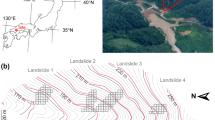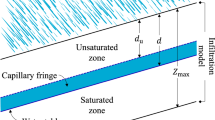Abstract
This study compares the performance of transient rainfall infiltration and grid-based regional slope stability (TRIGRS) model and time-variant slope stability (TiVaSS) model in the prediction of rainfall-induced shallow landslides. TRIGRS employs one-dimensional (1-D) subsurface flow to simulate the infiltration rate, whereas a three-dimensional (3-D) model is utilized in TiVaSS. The former has been widely used in landslide modeling, while the latter was developed only recently. Both programs are used for the spatiotemporal prediction of shallow landslides caused by rainfall. This study uses the July 2011 landslide event that occurred in Mt. Umyeon, Seoul, Korea, for validation. The performance of the two programs is evaluated by comparison with data of the actual landslides in both location and timing by using a landslide ratio for each factor of safety class (\({\text{LR}}_{\text{class}}\) index), which was developed for addressing point-like landslide locations. Moreover, the influence of surface flow on landslide initiation is assessed. The results show that the shallow landslides predicted by the two models are highly consistent with those of the observed sliding sites, although the performance of TiVaSS is slightly better. Overland flow affects the buildup of the pressure head and reduces the slope stability, although this influence was not significant in this case. A slight increase in the predicted unstable area from 19.30 to 19.93% was recorded when the overland flow was considered. It is concluded that both models are suitable for application in the study area. However, although it is a well-established model requiring less input data and shorter run times, TRIGRS produces less accurate results.











Similar content being viewed by others
References
Alvioli M, Baum RL (2016) Parallelization of the TRIGRS model for rainfall-induced landslides using the message passing interface. Environ Model Softw 81:122–135. doi:10.1016/j.envsoft.2016.04.002
Alvioli M, Guzzetti F, Rossi M (2014) Scaling properties of rainfall-induced landslides predicted by a physically based model. Geomorphology 213:38–47. doi:10.1016/j.geomorph.2013.12.039
An H, Yu S (2014) Finite volume integrated surface-subsurface flow modeling on non-orthogonal grids. Water Resour Res 50(3):2312–2328. doi:10.1002/2013WR013828
An H, Viet TT, Lee GH, Kim Y, Kim M, Noh S, Noh J (2016) Development of time-variant landslide-prediction software considering three-dimensional subsurface unsaturated flow. Environ Model Softw 85:172–183. doi:10.1016/j.envsoft.2016.08.009
Baek MH, Kim TH (2015) A study on the use of planarity for quick identification of potential landslide hazard. Nat Hazards Earth Syst Sci 15(5):997–1009
Baum RL, Savage WZ, Godt JW (2008) TRIGRS—A Fortran program for transient rainfall infiltration and grid-based regional slope stability analysis, version 2.0. Virginia, U.S. Department of the Interior. U.S. Geological Survey. pp 1–75
Baum RL, Godt JW, Savage WZ (2010) Estimating the timing and location of shallow rainfall-induced landslides using a model for transient, unsaturated infiltration. J Geophys Res 115(F3):1–26. doi:10.1029/2009JF001321
Caine N (1980) The rainfall intensity—duration control of shallow landslides and debris flows. Geogr Ann 62A(1–2):23–27
Catani F, Segoni S, Falorni G (2010) An empirical geomorphology-based approach to the spatial prediction of soil thickness at catchment scale. Water Resour Res 46(5):1–15. doi:10.1029/2008WR007450
Chang H, Kwon WT (2007) Spatial variations of summer precipitation trends in South Korea, 1973–2005. Environ Res Lett 2(4):1–9. doi:10.1088/1748-9326/2/4/045012
Formetta G, Capparelli G, Versace P (2015) Evaluating performances of simplified physically based models for landslide susceptibility. Hydrol Earth Syst Sci Discuss 12:13217–13256. doi:10.5194/hessd-12-13217-2015
Gardner WR (1958) Some steady-state solutions of the unsaturated moisture flow equation with application to evaporation from a water table. Soil Sci 85(4):228–232
Godt JW, Baum RL, Savage WZ, Salciarini D, Schulz WH, Harp EL (2008) Transient deterministic shallow landslide modeling: requirements for susceptibility and hazard assessments in a GIS framework. Eng Geol 102(3–4):214–226. doi:10.1016/j.enggeo.2008.03.019
Gostelow P (1991) Rainfall and landslides. In: Teixeira A (ed) Prevention and control of landslides and other mass movements. CEC, Brussels, pp 139–161
Huang J, Ju NP, Liao YJ, Liu DD (2015) Determination of rainfall thresholds for shallow landslides by a probabilistic and empirical method. Nat Hazards Earth Syst Sci 15(12):2715–2723. doi:10.5194/nhess-15-2715-2015
Iverson RM (1991) Sensitivity of stability analyses to groundwater data. In: Bell DH (ed) Proceedings of the sixth international symposium on landslides. Balkema, Rotterdam, pp 451–457
Iverson RM (2000) Landslide triggering by rain infiltration. Water Resour Res 36(7):1897–1910
Jeong S, Kim Y, Lee JK, Kim J (2015) The 27 July 2011 debris flows at Umyeonsan, Seoul, Korea. Landslides 12:799–813
Jung HS, Choi Y, Oh JH, Lim GH (2002) Recent trends in temperature and precipitation over South Korea. Int J Climatol 22(11):1327–1337
Kim J (2012). Hazard area mapping during extreme rainstorms in South Korean mountain. Department of Civil and Environmental Engineering. Colorado, Colorado State University. Ph.D. Thesis, p 145
Kim D, Im S, Lee SH, Hong Y, Cha KS (2010) Predicting the rainfall-triggered landslides in a forested mountain region using TRIGRS model. J Mt Sci 7(1):83–91
Korean Society of Civil Engineers (2011) Research contract report: causes survey and restoration work of Mt. Woomyeon landslide (in Korean), Seoul, pp 1–245
Lee SG, Lee KS, Villemin DC, Hencher S. (2008). Characteristics of landslides related to various rock types in Korea. In: Chen Z, Zhang J, Li Z, Wu F, Ho K (eds) 10th international symposium on landslides and engineered slopes. CRC Press, Xi’an, China, pp 427–433. doi: 10.1201/9780203885284-c44
Lu N, Likos WJ (2006) Suction stress characteristic curve for unsaturated Soil. J Geotech Geoenviron Eng 132(6):131–142
Mandal S, Maiti R (2015) Slope stability model and landslide susceptibility using geo-technical properties of soil. In: Semi-quantitative approaches for landslide assessment and prediction. Springer Natural Hazards, New York, pp 167–189. doi:10.1007/978-981-287-146-6_6
Montrasio L (2000). Stability analysis of soil slip. In: Brebbia CA (ed) International conference risk analysis II. Wit Press, Southampton, pp 357–366
Montrasio L, Valentino R (2008) A model for triggering mechanisms of shallow landslides. Nat Hazards Earth Syst Sci 8:1149–1159. doi:10.5194/nhess-8-1149-2008
Montrasio L, Valentino R, Losi GL (2011) Towards a real-time susceptibility assessment of rainfall-induced shallow landslides on a regional scale. Nat Hazards Earth Syst Sci 11(7):1927–1947. doi:10.5194/nhess-11-1927-2011
Mualem Y (1976) A new model for predicting the hydraulic conductivity of unsaturated porous media. Water Resour Res 12(3):513–522. doi:10.1029/WR012i003p00513
Ng CWW, Shi Q (1998) A numerical investigation of the stability of unsaturated soil slopes subjected to transient seepage. Comput Geotech 22(1):1–28
Park DW, Nikhil NV, Lee SR (2013) Landslide and debris flow susceptibility zonation using TRIGRS for the 2011 Seoul landslide event. Nat Hazards Earth Syst Sci 13(1):2833–2849. doi:10.5194/nhess-13-2833-2013
Park DW, Lee SR, Vasu NN, Kang SH, Park JY (2016) Coupled model for simulation of landslides and debris flows at a local scale. Nat Hazards 81(3):1653–1682. doi:10.1007/s11069-016-2150-2
Rahardjo H, Li XW, Toll DG, Leong EC (2001) The effect of antecedent rainfall on slope stability. Geotech Geol Eng 19(3):371–399. doi:10.1023/A:1013129725263
Rahardjo H, Ong TH, Rezaur RB, Leong EC (2007) Factors controlling instability of homogeneous soil slopes under rainfall. J Geotech Geoenviron Eng 133(12):1532–1543
Rahardjo H, Leong EC, Rezaur RB (2008) Effect of antecedent rainfall on pore-water pressure distribution characteristics in residual soil slopes under tropical rainfall. Hydrol Process 22(4):506–523. doi:10.1002/hyp.6880
Raia S, Alvioli M, Rossi M, Baum RL, Godt JW, Guzzetti F (2014) Improving predictive power of physically based rainfall-induced shallow landslide models: a probabilistic approach. Geosci Model Dev 7:495–514. doi:10.5194/gmdd-6-1367-2013
Rigon R, Bertoldi G, Over TM (2006) GEOtop: a distributed hydrological model with coupled water and energy budgets. J Hydrometeorol 7(3):371–388. doi:10.1175/JHM497.1
Sabastein KYF (2003). Stochastic analysis of coupled surface and subsurface flow model in steep slopes for slope stability analysis. Department of Civil Engineering. Hong Kong, Hong Kong University of Science and Technology. MsC, pp 1–242
Salciarini D, Godt J, Savage WZ, Baum RL, Conversini P (2008) Modeling landslide recurrence in Seattle, Washington, USA. Eng Geol 102(3–4):227–237. doi:10.1016/j.enggeo.2008.03.013
Salciarini D, Tamagnini C, Conversini P, Rapinesi S (2012) Spatially distributed rainfall thresholds for the initiation of shallow landslides. Nat Hazards 61(1):229–245. doi:10.1007/s11069-011-9739-2
Schmidt KM, Roering JJ, Stock JD, Dietrich WE, Montgomery DR, Schaub T (2001) The variability of root cohesion as an influence on shallow landslide susceptibility in the Oregon Coast Range. Can Geotech 38(5):995–1024. doi:10.1139/t01-031
Segoni S, Rossi G, Catani F (2012) Improving basin scale shallow landslide modelling using reliable soil thickness maps. Nat Hazards 61(1):85–101. doi:10.1007/s11069-011-9770-3
Simoni S, Zanotti F, Giacomo B, Rigon R (2008) Modelling the probability of occurrence of shallow landslides and channelized debris flows using GEOtop-FS. Hydrol Process 22(4):532–545. doi:10.1002/hyp.6886
Song YS, Kim KS (2014) Geotechnical properties of landslide sites in Korea with differing geology. In: Sassa K, Canuti P, Yin Y (eds) Landslide science for a safer geoenvironment, Vol 2. Springer, Switzerland, pp 87–92. doi:10.1007/978-3-319-05050-8_15
Srivastava R, Yeh TCJ (1991) Analytical solutions for one-dimensional, transient infiltration toward the water table in homogeneous and layered soils. Water Resour Res 27(5):753–762. doi:10.1029/90WR02772
Tesfa TK, Tarboton DG, Chandler DG, McNamara JP (2009) Modeling soil depth from topographic and land cover attributes. Water Resour Res 45(10):1–16. doi:10.1029/2008WR007474
Troch PA, Paniconi C, Emiel van Loon E (2003) Hillslope-storage Boussinesq model for subsurface flow and variable source areas along complex hillslopes: 1. Formulation and characteristic response. Water Resour Res 39(11):1–10. doi:10.1029/2002WR001728
Tsai TL, Wang JK (2010) Examination of influences of rainfall patterns on shallow landslides due to dissipation of matric suction. Environ Earth Sci 63(1):65–75. doi:10.1007/s12665-010-0669-1
Tsaparas I, Rahardjo H, Toll DG, Leong EC (2002) Controlling parameters for rainfall-induced landslides. Comput Geotech 29(1):1–27. doi:10.1016/S0266-352X(01)00019-2
Valentino R, Meisina C, Montrasio L, Lori L, Zizioli GL (2014) Predictive power evaluation of a physically based model for shallow landslides in the area of Oltrepò Pavese, Northern Italy. Geotech Geol Eng 32(4):783–805. doi:10.1007/s10706-014-9758-3
van Genuchten MT (1980) A closed-form equation for predicting the hydraulic conductivity of unsaturated soils. Soil Sci Soc Am J 44:892–898
Viet TT, Thu TM, Lee GH, Oh S, Van NTH (2015) Effect of extreme rainfall on cut slope stability: case study in Yen Bai City, Viet Nam. J Korean Geoenviron Soc 16(4):23–32. doi:10.14481/jkges.2015.16.4.23
Viet TT, Lee GH, Thu TM, An H (2016) Effect of digital elevation model resolution on shallow landslide modeling using TRIGRS. Nat Hazards Rev 18(2):1–12. doi:10.1061/(ASCE)NH.1527-6996.0000233
Yuan CC, Chae YK, Paik J, Kim G, Lee SW, Seo HS (2005) Analysis of time-varying rainfall infiltration induced landslide. Environ Geol 48(4):466–479. doi:10.1007/s00254-005-1289-z
Yune CY, Chae YK, Paik J, Kim G, Lee SW, Seo HS (2013) Debris flow in metropolitan area—2011 Seoul debris flow. J Mt Sci 10(2):199–206. doi:10.1007/s11629-013-2518-7
Zezere JL, Trigo RM, Trigo IF (2005) Shallow and deep landslides induced by rainfall in the Lisbon region (Portugal): assessment of relationships with the North Atlantic Oscillation. Nat Hazards Earth Syst Sci 5(3):331–344. doi:10.5194/nhess-5-331-2005
Zhang H, Zhang F, Shen K, Yuan M (2015). A surface and subsurface model for the simulation of rainfall infiltration in slopes. In: International symposium on geohazards and geomechanics (ISGG2015). IOP Publishing, Coventry, UK; vol 26, 1–16. doi: 10.1088/1755-1315/26/1/012025
Acknowledgements
This research is supported by the Korea Ministry of Environment (MOE) as “GAIA Program-2014000540005.”
Author information
Authors and Affiliations
Corresponding author
Rights and permissions
About this article
Cite this article
Tran, T., Lee, G., An, H. et al. Comparing the performance of TRIGRS and TiVaSS in spatial and temporal prediction of rainfall-induced shallow landslides. Environ Earth Sci 76, 315 (2017). https://doi.org/10.1007/s12665-017-6635-4
Received:
Accepted:
Published:
DOI: https://doi.org/10.1007/s12665-017-6635-4




